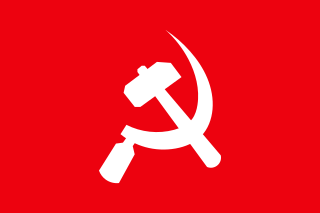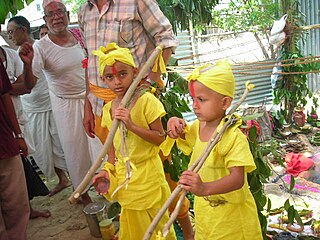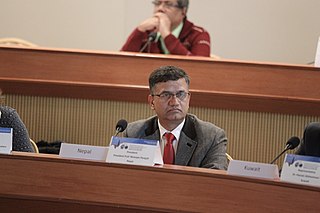
Man Mohan Adhikari (Magi) (Nepali: मन मोहन अधिकारी; 9 June 1920 – 26 April 1999) was the 31st Prime Minister of Nepal from 1994 to 1995, representing the Communist Party of Nepal (Unified Marxist-Leninist). He is the first communist Prime Minister in Nepal and one of the first communist politician in the world to be democratically elected as a head of government.

Khas tribe, popularly known as Khashya, according to the 2015 constitution of Nepal are an Indo-Aryan ethno-linguistic group native to the Himalayan region of the Indian subcontinent, in what is now the present-day South Asian country of Nepal, as well as the Indian states of Uttarakhand, West Bengal, Assam and Sikkim. Historically, Khas were the speakers of an ancient Khas language from the Indo-Aryan language family and the earliest recorded speakers of the Western Pahari languages. The large portion of the Indo-Aryan speakers throughout lower Himalayas were the Khas people. An intrusion of this tribe from the Western and Northwestern Himalayas into Central Himalayas is substantiated by the early linguistic evidences related to the Nepali language. They were also known as Parbatiyas/Parbates and are currently known as Paharis/Pahadis.. They were also referred to as Yartse in Tibet and are also known as Khasan by Bhotia people. The term Khas has now become obsolete, as the Khas people have adopted communal identities because of the negative stereotypes associated with the term Khas. In Nepal the native speaker of Nepali language are known as Khas people.

Chhetri, historically called Kshettriya or Kshetriya or Khas are Nepali speaking Rajputs of Khas community, some of whom trace their origin to migration from medieval India. Chhetri was a caste of administrators, governor and military elites in the medieval Khas Kingdom and Gorkha Kingdom. The nobility of the Gorkha Kingdom mainly originated from Chhetri families. They also had a strong presence in civil administration affairs. The bulk of prime ministers of Nepal before the democratization of Nepal belonged to this caste as a result of the old Gorkhali aristocracy. Gorkha-based aristocratic Chhetri families included the Pande dynasty, the Basnyat dynasty, the Kunwar family, and the Thapa dynasty,.

Nepali literature refers to literature written in the Nepali language. The Nepali language has been the national language of Nepal since 1958.
Nepali literature is the literature of Nepal. This is distinct from Nepali literature, which is the literature in only Nepali language. The major literary languages of Nepal are:

The 1973 Royal Nepal Airlines DHC-6 hijacking was the first aircraft hijacking in the history of Nepal.

General elections were held in Nepal from 18 February to 3 April 1959 to elect the 109 members of the first House of Representatives, the lower house of the Parliament of Nepal. They were held under the provisions of the 1959 constitution, which had been adopted on 12 February. More than 4.25 million people out of an overall population of about 8.55 million (1954) were eligible to vote. Voter turnout was 42.18%.

Ghimire is one of the surnames of the Brahmin varna belonging to Kashyap Gotra in the Hindu Varna System. The earliest known ancestor, the royal priest Gudpal Vyas, lived in Ghamir, Dhurkot, who moved from Ujjain, which was ruled by King Vikramaditya, ancient city situated on the eastern bank of the Kshipra River in the Malwa region of central India. Which is today part of the state of Madhya Pradesh, and it is the administrative centre of Ujjain District and Ujjain Division. Research Scholar, Parashu Ram Ghimire argues that the Brahmins who migrated from Ghamir to Musikot were called Ghamire/Ghimire, later in Musikot. In this logic claims Ghimire first started in Musikot.

Nepal Literature Festival is an annual international literary festival which takes place in Pokhara, Nepal. It was founded in 2011 by Bookworm Foundation, a not-for-profit organization.

Nepal Idol is a Nepali reality television singing competition that is part of the Idols franchise created and owned by FremantleMedia. Nepal Idol 2017 is the first season of Idol Franchise in Nepal which aired on AP1 TV.
"Melancholy" is an environmentally-themed song sung by 365 Nepali artists. This song was intended to promote an environmental message by breaking the Guinness World Records for "Most Vocal Solos in a Song Recording", which it successfully did. It was written, music composed and directed by environmentalist Nipesh Dhaka. The song was recorded as a single on 19 May 2016. The recording sessions were inaugurated by Prime Minister Khadga Prasad Oli at 8 am and continued until 6 pm. The song was released on 2 September 2017 by President Bidya Devi Bhandari at Army Officer's Club, Kathmandu.

Tagadhari are members of a Nepalese Hindu group that is perceived as historically having a high socio-religious status in society. Tagadhari are identified by a sacred thread (Janai) around the torso, which is used for ritualistic purposes in Hinduism. In Sanskrit the sacred thread is called yajñopavītam and in Nepali Janai. The cord is received after the Upanayana ceremony. Tagadharis were historically favoured by the government of Nepal and various religious and caste-based legal provisions were enacted on their behalf. The legal code of 1854, Muluki Ain, which was introduced by Chhetri Maharaja and Prime Minister of Nepal, Narsingh Jang Bahadur Kunwar Ranaji made it impossible to legally enslave Tagadharis and decreed fewer punishments for them in comparison to Matawali and Dalits.

Niranjan Parajuli is a Nepali chemist, biochemist and biotechnologist, who was President of Nepal Chemical Society (2019-2021) and Professor of Chemistry at the Central Department of Chemistry, Tribhuvan University, Nepal. Parajuli is also an advocate for change in the Nepali education system, writing op-eds for national dailies, particularly focusing on higher education. EduRank has sorted Professor Parajuli as a notable alumnus of Tribhuvan University.
Hari Devi Koirala is a Nepalese singer. She has sung over 800 songs and recorded more than 80 albums, in a career spanning 5 decades. Koirala has received over 250 awards from literary, musical, and social organizations. She quickly rose to fame after she recorded her first album Paina Khabara in Kathmandu. Some of her popular songs include "Aina Herera", "Paina Khabar", "Phoolko Basana", "Jhil Jhil Sitara", and "Aama Timro Dudhko Varale".











